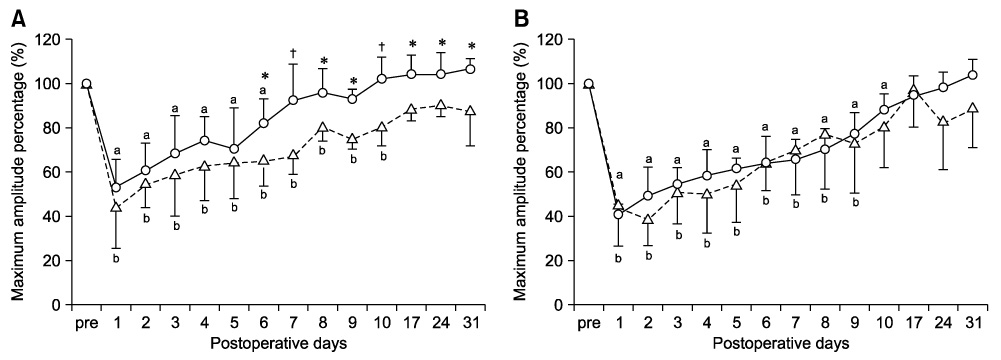J Vet Sci.
2009 Jun;10(2):157-160. 10.4142/jvs.2009.10.2.157.
Effects of mosapride on motility of the small intestine and caecum in normal horses after jejunocaecostomy
- Affiliations
-
- 1The United Graduate School of Veterinary Sciences, Gifu University, 1-1 Yanago, Gifu-shi, 501-1193, Japan.
- 2Department of Veterinary Clinical Science, Obihiro University of Agriculture & Veterinary Medicine, Inada, Obihiro, Hokkaido, 080-8555, Japan. naoki@obihiro.ac.jp
- 3Department of Veterinary Surgery and Anesthesiology, College of Veterinary Medicine, Seoul National University, Seoul 151-742, Korea.
- KMID: 1102973
- DOI: http://doi.org/10.4142/jvs.2009.10.2.157
Abstract
- The purpose of the present study was to evaluate the prokinetic effects of mosapride with non-invasive assessment of myoelectrical activity in the small intestine and caecum of healthy horses after jejunocaecostomy. Six horses underwent celiotomy and jejunocaecostomy, and were treated with mosapride (treated group) at 1.5 mg/kg per osos once daily for 5 days after surgery. The other six horses did not receive treatment and were used as controls (non-treated group). The electrointestinography (EIG) maximum amplitude was used to measure intestinal motility. Motility significantly decreased following surgery. In the treated group, the EIG maximum amplitude of the small intestine was significantly higher than in the controls from day 6~31 after treatment. These findings clearly indicate that mosapride could overcome the decline of intestinal motility after jejunocaecostomy in normal horses.
Keyword
MeSH Terms
-
Anastomosis, Surgical/veterinary
Animals
Benzamides/*pharmacology
Cecum/*drug effects/physiology
Electrophysiology
Female
Gastrointestinal Agents/*pharmacology
Gastrointestinal Motility/*drug effects
Horses/*physiology/surgery
Intestine, Small/*drug effects/physiology/surgery
Jejunostomy/veterinary
Male
Morpholines/*pharmacology
Figure
Reference
-
1. Bauer AJ, Boeckxstaens GE. Mechanisms of postoperative ileus. Neurogastroenterol Motil. 2004. 16:Suppl 2. 54–60.
Article2. Cohen ND, Lester GD, Sanchez LC, Merritt AM, Roussel AJ Jr. Evaluation of risk factors associated with development of postoperative ileus in horses. J Am Vet Med Assoc. 2004. 225:1070–1078.
Article3. Dart AJ, Hodgson DR. Role of prokinetic drugs for treatment of postoperative ileus in the horse. Aust Vet J. 1998. 76:25–31.
Article4. Donawick WJ, Christie BA, Stewart JV. Resection of diseased ileum in the horse. J Am Vet Med Assoc. 1971. 159:1146–1149.5. Embertson RM, Colahan PT, Brown MP, Peyton LC, Schneider RK, Granstedt ME. Ileal impaction in the horse. J Am Vet Med Assoc. 1985. 186:570–572.6. Ford TS, Freeman DE, Ross MW, Richardson DW, Martin BB, Madison JB. Ileocecal intussusception in horses: 26 cases (1981-1988). J Am Vet Med Assoc. 1990. 196:121–126.7. Frankeny RL, Wilson DA, Messer NT, Campbell-Beggs C. Jejunal intussusception: a complication of functional end-to-end stapled anastomoses in two ponies. Vet Surg. 1995. 24:515–517.
Article8. Freeman DE. Surgery of the small intestine. Vet Clin North Am Equine Pract. 1997. 13:261–301.
Article9. Kajimoto T. Relation between electrogastrography and gastric electromyogram, mechanical activity. J Smooth Muscle Res. 1995. 31:93–107.
Article10. Sasaki N, Lee I, Ayukawa Y, Yamada H. Clinical applications of electrointestinography in the horse. J Equine Sci. 2004. 15:85–92.
Article11. Sasaki N, Mizuno Y, Yoshihara T. The application of electrocecography for evaluation of cecum motility in horses. J Vet Med Sci. 1998. 60:1221–1226.
Article12. Sasaki N, Murata A, Lee I, Yamada H. Evaluation of equine cecal motility by ausculation, ultrasonography and electrointestinography after jejunocecostomy. Res Vet Sci. 2008. 84:305–310.
Article13. Sasaki N, Okamura K, Yamada H. Effects of mosapride, a 5-hydroxytryptamine 4 receptor agonist, on electrical activity of the small intestine and cecum in horses. Am J Vet Res. 2005. 66:1321–1323.
Article14. Smith CL, Dowling BA, Dart AJ. Recent advances in equine abdominal surgery. Vet J. 2005. 170:41–51.
Article15. Van Hoogmoed LM, Nieto JE, Snyder JR, Harmon FA. Survey of prokinetic use in horses with gastrointestinal injury. Vet Surg. 2004. 33:279–285.
Article16. Weiss R, Abel D, Scholtysik G, Straub R, Mevissen M. 5-Hydroxytryptamine mediated contractions in isolated preparations of equine ileum and pelvic flexure: pharmacological characterization of a new 5-HT(4) agonist. J Vet Pharmacol Ther. 2002. 25:49–58.
Article17. Yoshida N, Ito T, Karasawa T, Itoh Z. AS-4370, a new gastrokinetic agent, enhances upper gastrointestinal motor activity in conscious dogs. J Pharmacol Exp Ther. 1991. 257:781–787.18. Yoshida N, Omoya H, Oka M, Furukawa K, Ito T, Karasawa T. AS-4370, a novel gastrokinetic agent free of dopamine D2 receptor antagonist properties. Arch Int Pharmacodyn Ther. 1989. 300:51–67.
- Full Text Links
- Actions
-
Cited
- CITED
-
- Close
- Share
- Similar articles
-
- Investigation into the Effects of Mosapride on Motility of Guinea Pig Stomach, Ileum, and Colon
- Effects of 5-HT4 selective receptor agonist, mosapride citrate on electrocardiogram in dogs
- Effects of Mosapride Citrate on the Motility of Stomach, Ileum and Colon in Conscious Guinea Pigs
- Effect of Mosapride Citrate and Combined Treatment with Ondansetron on Postoperative Ileus in Rats
- Microflora Modulation of Motility



